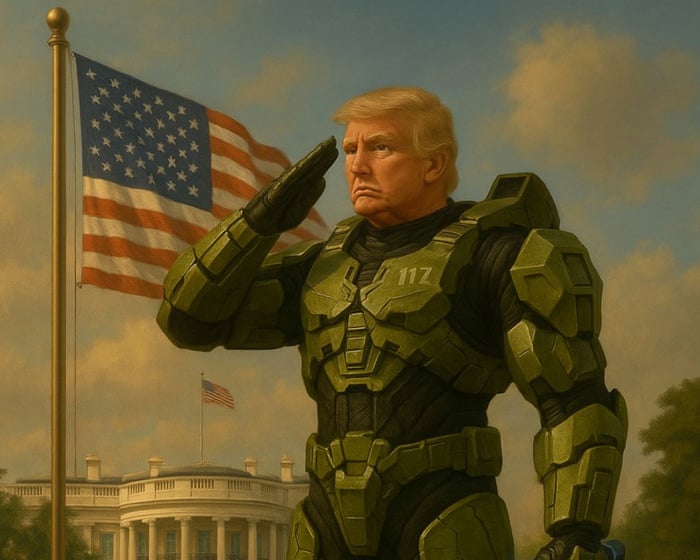Shortly after Microsoft unveiled Halo: Campaign Evolved, the latest installment in its popular sci-fi series, the White House posted a striking image on X. The picture, seemingly AI-generated, depicts Donald Trump dressed as Halo’s iconic hero, Master Chief, saluting in front of an American flag missing several stars. He holds an energy sword, a weapon used by alien foes in the games. The post, a reply to a tweet from GameStop, carries the caption “Power to the Players,” echoing the retailer’s slogan.
GameStop and the White House exchanged a few more Halo-themed memes, and on October 27, the Department of Homeland Security’s X account joined in. It used Halo imagery of a futuristic soldier in an alien landscape to promote its increasingly militarized Immigration and Customs Enforcement (ICE) agency, with the message “Stop the Flood”—comparing immigrants to the parasitic aliens Master Chief fights.
When asked for comment, White House deputy press secretary Kush Desai stated via email, “Yet another war ended under President Trump’s watch—only one leader is fully committed to giving power to the players, and that leader is Donald J Trump. That’s why he’s hugely popular with the American people and American gamers.” Microsoft did not respond to requests for comment.
This wave of video game imagery might seem unusual, but Trump and his allies have been engaging with gamer culture for nearly a decade. Since his first presidential campaign, Trump has targeted gamers—a group that includes many disaffected young men. In August 2016, media executive Steve Bannon joined the campaign as chief strategist, bringing deep knowledge of video game culture and online fan behavior.
Bannon had previously worked with and secured funding for Internet Gaming Entertainment, a Hong Kong company that employed low-wage Chinese workers to farm virtual currency in World of Warcraft. According to Joshua Green’s book “Devil’s Bargain: Steve Bannon, Donald Trump, and the Storming of the Presidency,” Bannon realized during this time that “these rootless white males had monster power.” In 2014, he observed Gamergate, an online movement that harassed women and marginalized individuals in the gaming industry, and saw how it led to real-world actions like organized bullying and doxing.
Once on the Trump campaign, Bannon used his understanding of gamer culture to reach new audiences. He told Green, “You can activate that army. They come in through Gamergate or whatever and then get turned on to politics and Trump.”
This online army was primed for meme warfare and actively participated. Throughout the 2016 campaign, Trump’s supporters closely tracked Hillary Clinton, spreading false claims about her health with #HillaryHealth and creating memes that blended internet humor and pop culture references. Many argue this support helped Trump defeat Clinton.
After losing to Joe Biden in 2020, Trump turned to his platform Truth Social to criticize Biden and Democrats throughout his term, continuing to appeal to gamers and the online right before securing the presidency again.As Trump seeks the presidency once more, his campaign continues to employ the strategies of online agitators, but with a significant new factor: Elon Musk. After purchasing Twitter in October 2022, Musk swiftly reinstated Trump’s account and many others that had been banned. A frequent poster of memes and references to gamer culture—even amid a brief controversy over whether he was exaggerating his gaming experience—Musk relaxed the platform’s hate speech policies and amplified the very toxic gamer culture that the White House is now embracing.
Since Trump’s inauguration in January, the White House and federal agencies have embraced meme culture. Last month, the Department of Homeland Security’s X account and the White House’s TikTok shared a video of ICE raids set to the Pokémon theme song, mixing scenes from the animated series with footage of arrests and using the franchise’s “Gotta catch ’em all” slogan. The Pokémon Company International told the BBC that it did not grant permission for the use of its intellectual property, yet the video remains online as of this writing.
The video game industry has largely stayed silent as reactionary politics spread within gaming communities. For millions of American gamers who are deeply troubled by an administration that warns pregnant women against Tylenol, portrays immigrants as parasites, or claims diversity and inclusion lead to unqualified workers, this alignment is deeply frustrating. As the administration increasingly adopts video game imagery and internet memes, game companies find themselves linked to divisive right-wing politics, whether they like it or not.
Frequently Asked Questions
Of course Here is a list of FAQs about the White Houses use of video game memes to recruit for ICE designed with clear questions and direct answers
BeginnerLevel Questions
1 What is this about Did the White House really use video game memes
Yes during the Trump administration the official White House and ICE social media accounts posted recruitment ads that used popular memes and aesthetics from video game culture
2 What is a video game meme in this context
It refers to using popular images slogans or visual styles from video games For example they used graphics that looked like a mission objective screen from a firstperson shooter game to frame working for ICE as an exciting mission
3 Why would they do this
The goal was to attract a younger techsavvy audiencespecifically people who play video gamesby speaking their language and making a government job seem dynamic and actionoriented
4 What is ICE and what does it do
ICE is a federal law enforcement agency under the Department of Homeland Security Its mission is to enforce federal laws governing border control customs trade and immigration
5 Was this a common way for the government to recruit
No it was a significant departure from traditional government recruitment campaigns which are typically more formal and focus on benefits patriotism and career stability
Advanced Critical Questions
6 What was the public reaction to this strategy
The reaction was sharply divided Supporters saw it as a clever and modern way to reach new recruits Critics argued it was inappropriate and trivialized the serious often lifealtering nature of immigration enforcement by comparing it to a game
7 What are the main criticisms of using this tactic
The main criticisms are
Gamification of Serious Issues It can make complex and sensitive realworld problems seem like a simple consequencefree game
Target Audience Mismatch The culture of many online gaming communities often values freedom and antiauthoritarianism which may clash with the image of a federal enforcement agency
Political Messaging Many saw it as a political stunt to energize a specific base rather than a genuine effective recruitment tool
8 Did this recruitment strategy actually work
Its difficult to measure its direct success in




